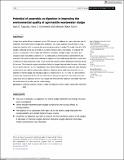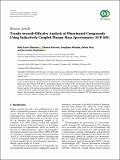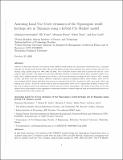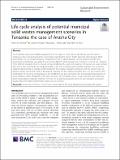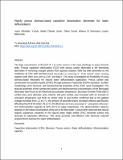Research Articles: Recent submissions
Now showing items 361-380 of 564
-
Potential of anaerobic co-digestion in improving the environmental quality of agro-textile wastewater sludge
(IWA Publishing, 2020-08-30)Sludge from textile effluent treatment plants (ETP) remains a challenge for many industries due to inefficient and limited waste management strategies. This study explores the potential of using anaerobic digestion (AD) ... -
Why prepaid technologies are not a panacea for inclusive and sustainable rural water services in Tanzania?
(IWA Publishing, 2020-08-26)Poor sustainability of rural water schemes is a major problem in service delivery in sub-Saharan Africa. About half of the schemes fail one year after commissioning, mostly due to poor operation and maintenance. Many ... -
Simulation and performance analysis of municipal solid waste gasification in a novel hybrid fixed bed gasifier using Aspen plus
(Taylor & Francis Online, 2020-08-27)Thermochemical conversion technologies (incineration, gasification, and pyrolysis) have emerged as potential technologies for municipal solid waste management. Incineration is the most common thermo-chemical technology ... -
Trends towards Effective Analysis of Fluorinated Compounds Using Inductively Coupled Plasma Mass Spectrometry (ICP-MS)
(Hindawi, 2021-02-03)Increased demand for monitoring and identification of novel and unknown fluorinated compounds (FCs) has demonstrated the need of sensitive fluorine-specific detectors for unknown FCs in both biological and environmental ... -
Seasonal profitability of soil and water conservation techniques in semi-arid agro-ecological zones of Makanya catchment, Tanzania
(Elsevier B.V., 2021-01-01)Soil and water conservation techniques are known to be profitable and widely promoted in sub-Saharan Africa. However, how their profitability vary across cropping seasons has not been fully explored. Thus, farmers are often ... -
Influence of land use change on nitrate sources and pollutant enrichment in surface and groundwater of a growing urban area in Tanzania
(Springer Nature Switzerland AG., 2021-01-31)In the present study, 3-year (1997, 2008 and 2017) satellite images as well as different hydro-chemical parameters, nitrogen and oxygen isotopic composition of nitrate were used to examine the impacts of land use and land ... -
Assessing Land Use/Cover dynamics of the Ngorongoro world heritage site in Tanzania using a hybrid CA–Markov model
(Authorea, 2020-10)In this study, land-use/cover pattern of the UNESCO world heritage site, Ngorongoro Conservation Area; is analyzed using the CA–Markov model with the help of RS and GIS. Hybrid classification techniques ware used to monitor ... -
Life cycle analysis of potential municipal solid wastes management scenarios in Tanzania: the case of Arusha City
(Springer Nature, 2021-01-07)The municipal solid wastes (MSW) management technologies in most cities of developing countries pose a continuous risk of contaminating the environment and affecting human health adversely; often because MSW technologies ... -
Predicting land use/cover changes and its association to agricultural production on the slopes of Mount Kilimanjaro, Tanzania
(Taylor & Francis Online, 2021-01-11)Increasing demand for food production results in Land use and land cover (LULC) changes, which afflicts the provision of ecosystem services in high mountain areas. This work used time-series LULC and selected spatial metrics ... -
Betanidin isomerisation and decarboxylation, thermodynamic and charge transfer dye properties towards dye sensitised solar cells application
(John Wiley & Sons, Inc., 2021-01-25)Along with attractiveness of natural dyes for solar technologies, the instability is a well‐known drawback of the dyes, which impedes their usage for dye sensitised solar cells (DSSCs) application. The planar isomer appeared ... -
Effects of Climate Smart Agricultural practices and Planting Dates on Maize Growth and Nutrient Uptake in Semi-Arid Tanzania
(International Journal of Biosciences, 2020-05-15)The shift of growing season’s onset due to rainfall and seasonal variability are among the climate change impacts affecting agricultural productivity in semi-arid. Previous studies have also noted the seasonal variations ... -
High energy density materials based on fluorinated bridged trinitromethyl azo triazole derivatives: a quantum chemical study of thermodynamic and energetic properties
(Springer Nature Switzerland AG., 2020-10-19)High energy density materials (HEDM) have gained extensive attention due to their energetic properties and safety issues. Nitro and fluoro groups, among others, have become viable substituents on the triazole framework ... -
Two-stage banana leaves wastes utilization towards mushroom growth and biogas production
(Springer Nature Switzerland AG., 2020-11-20)Banana leaves wastes (BL) were subjected to fungal treatment using Pleurotus ostreatus to produce edible mushrooms and biogas in the anaerobic digestion process. Effects of fungal treatment on mushrooms production, lignin ... -
Theoretical and Experimental Performance Analysis of a Novel Domestic Biogas Burner
(Hindawi, 2020-09-16)The inefficient indoor burning of fuelwood on traditional cookstoves generates pollutants, primarily carbon monoxide and many other human health-damaging emissions. It is from this risk that it is necessary to have an ... -
Open-Source Software Application for Hydrogeological Delineation of Potential Groundwater Recharge Zones in the Singida Semi-Arid, Fractured Aquifer, Central Tanzania
(MDPI, 2020-05-17)This study attempted to delineate and map potential groundwater recharge zones of the Singida, semi-arid, fractured crystalline basement aquifer using open source remote sensing and GIS software. Various thematic maps ... -
Experimental Study of a Lab Scale Hybrid Fixed Bed Gasifier
(Science Publishing Group, 2020-02-04)Thermo-chemical conversion technologies (incineration, gasification and pyrolysis) have emerged as potential technologies for municipal solid waste management (MSWM). This is happening due to the increase of the need for ... -
Performance investigation of the slaughterhouse wastewater treatment facility: a case of Mwanza City Slaughterhouse, Tanzania
(Water Practice & Technology, 2020-09-28)The present study engaged onsite operations and laboratory analysis for Mwanza City Slaughterhouse (MCS) wastewater to improve the efficiency of wastewater treatment of a newly installed facility. The MCS wastewater treatment ... -
Fast Rate Production of Biodiesel from Neem Seed Oil Using a Catalyst Made from Banana Peel Ash Loaded with Metal Oxide (Li-CaO/Fe2 (SO4)3)
(Hindawi, 2020-08-27)Biodiesel is a possible remedy to the present toxic, finite sources and ever-diminishing crude fuels. Nonedible and locally available (Azadirachta indica) neem seed oil (NSO) as a second-generation feedstock was transformed ... -
Highly porous biomass-based capacitive deionization electrodes for water defluoridation
(Springer Nature Switzerland AG., 2019-12-09)The high concentration of fluoride (F−) in water sources is the main challenge in major fluoride belts. Though capacitive deionization (CDI) with porous carbon electrodes is the promising alternative in removing charged ... -
Quantitative assessment of metal contamination and associated pollution risk in sediments from the Mara River in Tanzania
(Springer Nature Switzerland AG., 2020-10-21)For most rivers in sub-Saharan Africa, information about pollution indices related to sediments is sparse. Sedimentological research of rivers that empty into Lake Victoria is highly patchy and wide apart. The present study ...

